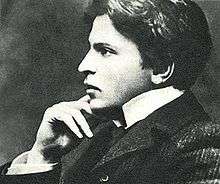Piano Quartet No. 1 (Enescu)

Piano Quartet No. 1 in D major, Op. 16, is a chamber-music composition by the Romanian composer George Enescu, written in 1909.
History
Enescu composed his First Piano Quartet in 1909: the first movement in Sinaia, the remaining two movements in Paris. The work was completed on 10 December, just over a week prior to the concert for which it was premiered, in the series Soirées d'Art on 18 December 1909—a programme that also included the premiere of the already ten-year-old Octet for Strings. The score is dedicated to Mme Ephrussi, the wife of the Parisian banker Michel Ephrussi (Bentoiu 2010, 136; Hoffman and Rațiu 1971, 354–55; Malcolm 1990, 273).
There were only two further performances of the Quartet in the composer's lifetime: on 18 May 1910, and again in 1933, both times with the composer at the piano. It seems likely that Enescu had doubts about the work and might have wished to revise the score. This never happened, however, and the Quartet remained unpublished until 1965, a decade after the composer's death (Malcolm 1990, 94; Bentoiu 2010, 136–37).
Analysis
The quartet is in three movements:
- Allegro moderato
- Andante mesto
- Vivace
The opening movement, a sonata-allegro in D major, starts with the principal theme presented in the unison—a device of which Enescu was fond. This theme resembles the first theme of Enescu's Wind Decet, composed three years earlier, but its development occasionally looks forward to the heterophony characteristic of Enescu's later style (Bentoiu 2010, 127–28).
The central Andante movement is a song form in the key of A-flat minor, a tritone away from the home key of the outer movements—a relationship that Enescu will explore again in the Second Symphony (Bentoiu 2010, 131). The main theme is particularly expressive, with modal coloring, and is presented at the outset of the movement in the cello (Hoffman and Rațiu 1971, 355). The second theme group is largely derived from the first theme, but displays a scalewise melodic cell alternating semitones and whole tones, which will emerge as a full descending octatonic scale five bars after rehearsal 39. In the coda, the piano unexpectedly introduces the secondary theme of the first movement, which is the only cyclic feature found in this work (Bentoiu 2010, 132–33).
The finale is, like the opening movement, in sonata-allegro form, but opens unexpectedly in D minor rather than major (Bentoiu 2010, 133). It possesses a relentless rhythmic pulsation which, together with a vigorous cheerfulness, serves well the traditional function of a finale, but also that of a scherzo, a movement this work lacks (Firca 1965).
References
- Bentoiu, Pascal. 2010. Masterworks of George Enescu: A Detailed Analysis, translated by Lory Wallfisch. Lanham, MD: Scarecrow Press. ISBN 978-0-8108-7665-1 (cloth) ISBN 978-0-8108-7690-3 (ebook).
- Firca, Clemansa Liliana. 1965. Liner notes to the LP recording of the Quartet by Maria Fotino (piano), Daniel Podlovski (violin}, Alexandru Rădulescu (viola), and Ion Fotino (violoncello). 1 disc: 33⅓ rpm, stereo. Electrecord ECE 0271. Bucharest: Electrecord.
- Hoffman, Alfred, and Adrian Rațiu. 1971. "Muzician Internațional (1907–1913)". In George Enescu: Monografie, 2 vols., edited by Mircea Voicana, 331–404. Bucharest: Editura Academiei Republicii Socialiste România.
- Malcolm, Noel. 1990. George Enescu: His Life and Music, with a preface by Sir Yehudi Menuhin. London: Toccata Press. ISBN 0-907689-32-9.